

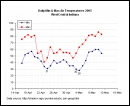
![]() orn
planted in early April in Indiana was injured to varying degrees by a combination
of cold temperatures and frost injury that occurred from late April through
early May. Air temperatures on the morning of May 4 were particularly cold,
officially dipping to 28F for a brief period of time at the Purdue Agronomy
Farm near West Lafayette (PAAWS,
2005 ).
orn
planted in early April in Indiana was injured to varying degrees by a combination
of cold temperatures and frost injury that occurred from late April through
early May. Air temperatures on the morning of May 4 were particularly cold,
officially dipping to 28F for a brief period of time at the Purdue Agronomy
Farm near West Lafayette (PAAWS,
2005 ).
Official NWS air temperatures are measured five feet above the ground. One
of my own temperature sensors located 8 inches above the soil in my planting
date plots at the Crop Diagnostic Training Center 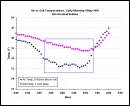 recorded temperatures lower than 28F for 2.5 hours
and bottomed out at 25.5 to 26.5F for about 30 minutes.
recorded temperatures lower than 28F for 2.5 hours
and bottomed out at 25.5 to 26.5F for about 30 minutes.
The good news for the corn plants was that soil temperatures did not similarly bottom out at sub-30F temperatures. A temperature sensor located 1-inch below the soil surface (about the depth of a corn plant's growing point) indicated that temperatures never dropped lower than about 34F. Consequently, most of the injury from frost or freezing temperatures was limited to the above-ground leaf tissue and not to the below-ground growing point regions of the corn plants.
The good news with injury that is limited to above-ground leaf tissue of young corn plants is that whorl recovery can usually occur with negligible long term effects on the crop. The following images depict a time sequence of recovery from frost/freeze injury to two adjacent corn plants in a plot planted 10 April. The plants differ dramatically for severity of visible damage to the above-ground leaf tissue, yet both eventually recover similarly.
Gallery 1: Pair of plants, one more severely injured by frost/freeze (right) than the other (left)
Gallery 2: Closer views of less severely injured plant.
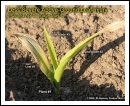 Evening of May 4: Death of leaf tips due to frost/freeze
injury. Evening of May 4: Death of leaf tips due to frost/freeze
injury. |
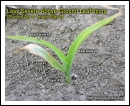 Beginning recovery of whorl 48 hours later on
the evening of May 6. Beginning recovery of whorl 48 hours later on
the evening of May 6. |
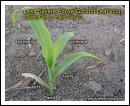 Evening of May 10. Evening of May 10. |
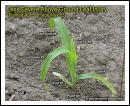 May 13. May 13. |
Gallery 3: Closer views of more severely injured plant.
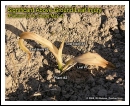 Evening of May 4: Nearly total death of above-ground
leaf tissue due to frost/freeze injury. Evening of May 4: Nearly total death of above-ground
leaf tissue due to frost/freeze injury. |
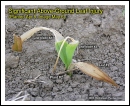 Beginning recovery of whorl 48 hours later on
the evening ofMay 6. Beginning recovery of whorl 48 hours later on
the evening ofMay 6. |
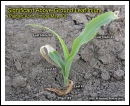 Evening of May 10. Evening of May 10. |
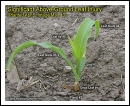 May 13. May 13. |
Purdue Automated Agricultural Weather Stations Network. 2005. Available online at http://shadow.agry.purdue.edu/sc.zen-geog.html [URL verified 5/31/05].
Nielsen, R.L. (Bob). 2005a. I’ve Got The Corny Stand Establishment Blues…. Corny News Network, Purdue Univ. Available online at http://www.kingcorn.org/news/articles.05/StandEstablishment-0503.html [URL verified 5/31/05].